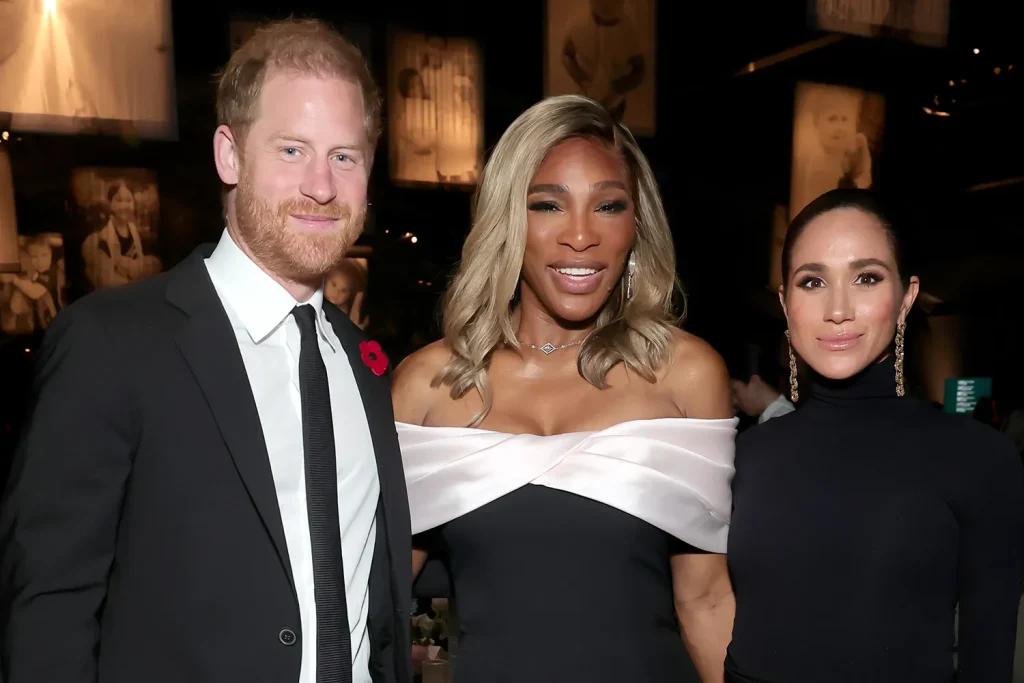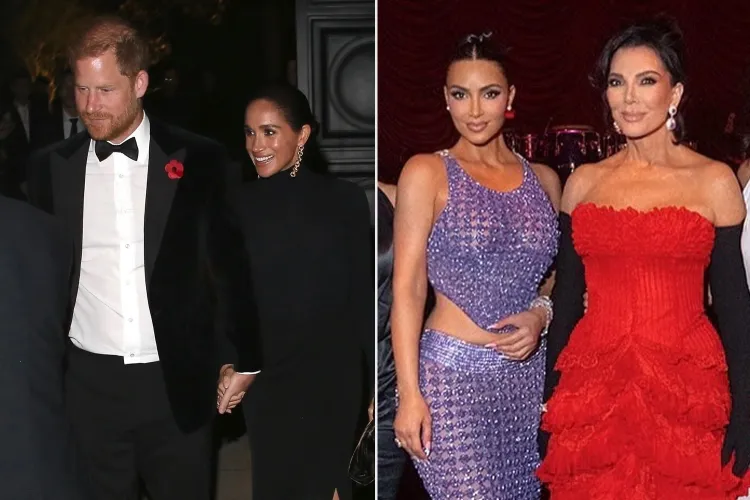Why Did Kim Kardashian and Kris Jenner Quietly Remove Meghan Markle and Prince Harry’s Images from Jenner’s Star-Studded 70th Birthday Party?
Last weekend’s celebration of Kris Jenner’s 70th birthday appeared for a moment to combine the worlds of royalty and reality television in one extravagant evening. The James Bond–themed party, held at Jeff Bezos and Lauren Sánchez’s Beverly Hills compound on November 8, 2025, brought together some of Hollywood’s biggest names—Oprah Winfrey, Beyoncé, Adele, Mark Zuckerberg and many more. Among the high-profile guests were Meghan Markle and Prince Harry, the Duke and Duchess of Sussex. According to a source cited by People magazine, they arrived “hand-in-hand and looked very happy.”

On the surface, their presence seemed to suggest a smooth Hollywood-royal cameo: Meghan in a striking black wrap-style dress with a thigh-high slit, and Harry in a classic tuxedo bearing a red remembrance poppy, honoring the Nov. 11 Remembrance Day holiday in the U.K. Both in-line with the glitzy theme of the evening and the glamorous guest list.
Initial social media documentation of the event also reflected their attendance. Jenner posted a carousel of Instagram images from the night, including a shot of herself with Meghan and Harry; her daughter Kim Kardashian similarly shared a post featuring Meghan, with Harry visible in the background.
Yet within hours, observers noted that both Jenner and Kardashian had quietly deleted the images featuring the Sussexes. Jenner’s carousel remained live, but the specific photo with Meghan and Harry was removed; Kardashian’s post likewise scrubbed the images showing the couple. No explanation was offered publicly.

That act of deletion—so seemingly minor yet so visible—has ignited headlines and speculation. Some have suggested it could be about brand control, image rights, or concerns about how the royal couple’s presence aligns with the Kardashian-Jenner brand. Others see deeper implications: in the continuing redefinition of Harry and Meghan’s post-royal identity, in the optics of Hollywood inclusion, and in the ways social-media posts are curated in real time.
To understand the significance, one must consider multiple perspectives. On the one hand, this may have been a simple case of behind-the-scenes management: a decision to remove images that, for one reason or another, were deemed unsuitable for long-term posting. Perhaps rights permissions were unclear, perhaps an association was reconsidered, or perhaps it was a precautionary move to limit tabloid use. As one outlet reported, Jenner’s team asked attendees for photo-use clearance ahead of the event.
On the other hand, the symbolism of the moment is hard to ignore. Harry and Meghan walked into the heart of Hollywood royalty—among the most visible celebrity family in America, and a room teeming with billionaire-level guests and entertainment icons. That intersection of worlds is rare. But those same worlds operate under distinct rules of image, reputation and narrative control. The Sussexes, since stepping back from royal duties in 2020, have placed heavy emphasis on shaping their own media presence; their alignment with one celebrity enclave or another carries weight.
From a brand-management standpoint, the deletion sends a clear message: visibility is managed, and when the calculus changes, removal can be as meaningful as posting. The deleted images become, by virtue of their absence, the story. For Kardashian and Jenner, whose social feeds are global brand platforms, the decision must have weighed both exposure and consequence. For Harry and Meghan, who navigate both royal legacy and celebrity platform, appearance in such a setting may have required careful framing—which may explain the quiet extraction of the optics.
Some analysts raise another layer: the broader royal ecosystem and its sensitivities. Reporting in The New York Post cited an unnamed palace-adjacent source calling the appearance “so tacky,” referring to the tension between Hollywood spectacle and the calmer style of public duty preferred by the rest of the royal family. If this description holds, it underscores how media optics for the Sussexes are not only about celebrity status, but are also observed through the lens of monarchy and symbolism.
The timing adds to the intrigue. The party landed just a day after Remembrance Day observances — an event deeply significant in the U.K. and a gesture clearly marked by Harry’s poppy pin. The contrasting backdrop of a high-glamour Hollywood soirée at the home of Jeff Bezos puts spotlight on the dual identity the Sussexes now embody: at once former royals, now high-profile celebrities. Their attendance and then the image removal raise questions about alignment, narrative consistency and image context.
And what about Jenner and Kardashian? From the perspective of the media business they run, their event was a spectacle of scale and star power: a themed party with guests from nearly every segment of global fame. Having the Sussexes present added further headline potential—but perhaps also headline risk. Deleting the images may reflect a strategic clean-up: preserving the glamour of the event while removing an element of complexity.
For the public and the media, the missing frame stands out in a sea of posted frames. Social-media commenters noticed quickly. One user wrote under Kardashian’s feed: “Wait, where did the not Duchess of Sussex go??” Others asked simply: “Where did the photo of royals go.” The act triggered speculation: Was there an issue of licensing, or perhaps a last-minute reconsideration of association? Some offerings noted the possibility that the image was deleted ahead of U.K. media noticing the juxtaposition with Remembrance Day.
In essence, the situation illustrates how power, identity and brand intersect in the digital age. A posted photo is not just a moment caught; it is a signal broadcast. A deleted photo becomes a signal too. For Jenner, Kardashian, Harry and Meghan, the decision to remove those images highlights how appearance is curated, and how what remains unseen often speaks as loudly as what is seen.
As of now, neither the Kardashian-Jenner camp nor representatives for the Sussexes have offered public comment about the deletions. The absence of explanation has only added fuel to the speculation. But perhaps that lack of comment is itself instructive: when it comes to high-stakes image management, silence can be strategic.
Looking ahead, the public eye will likely remain on this pair of families—Hollywood’s matriarchal empire and the royal couple turned global media brand. When they converge, the optics matter. When they diverge, the erasure matters. Whether the deletion suggests a closer alignment or a discreet separation, it underscores that in the worlds of celebrity and royalty alike, what you don’t see may shape perception as much as what you do.
In the final analysis, the party remains a glittering event: a night of celebration, costumes, stars and shared laughter. But the missing photos add an after-glow of intrigue. For Kris Jenner, Kim Kardashian, Meghan Markle and Prince Harry, this chapter serves as a reminder that in the curated world of image, the most potent moves may come not in what is shown—but in what is quietly removed.


